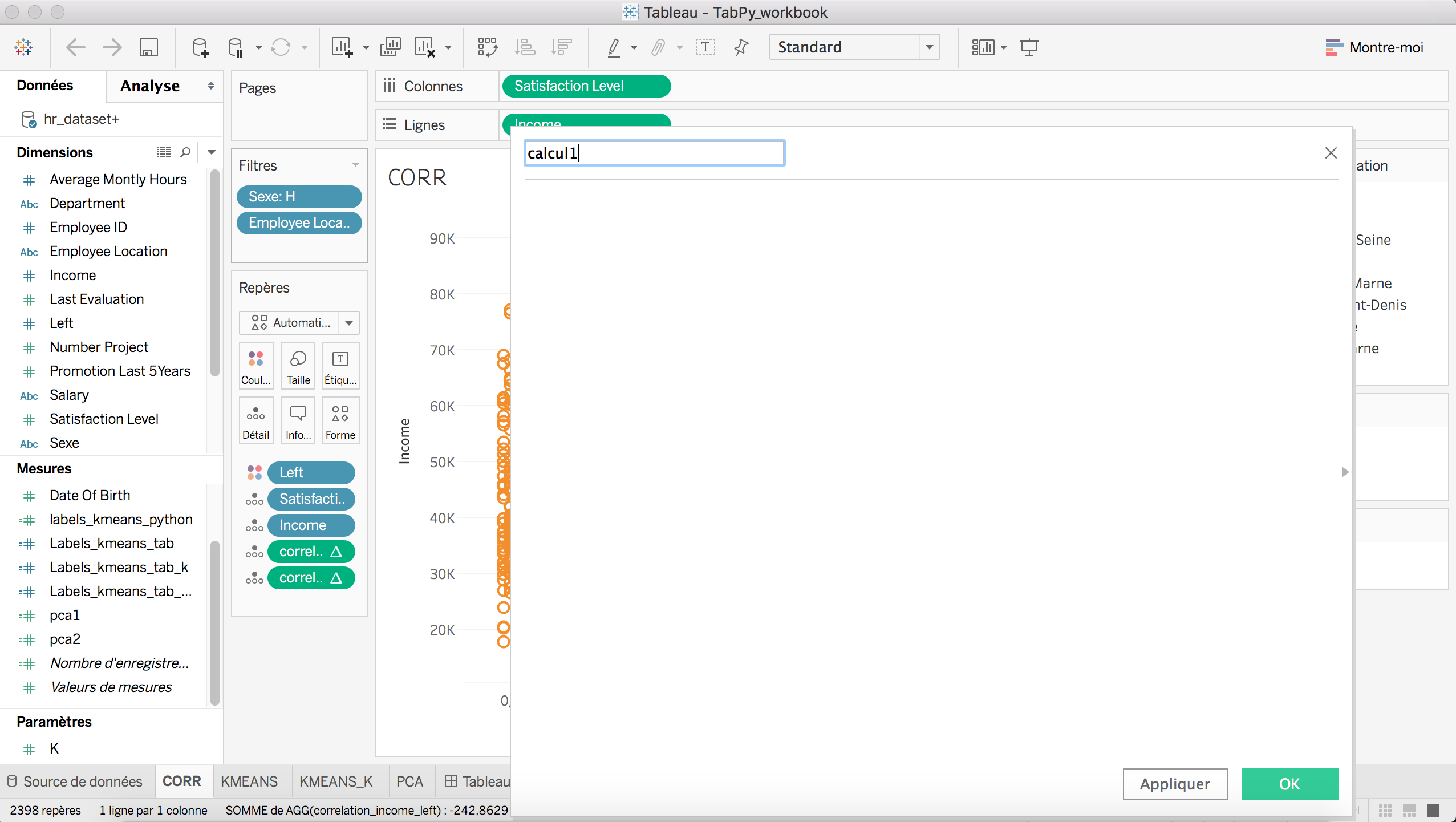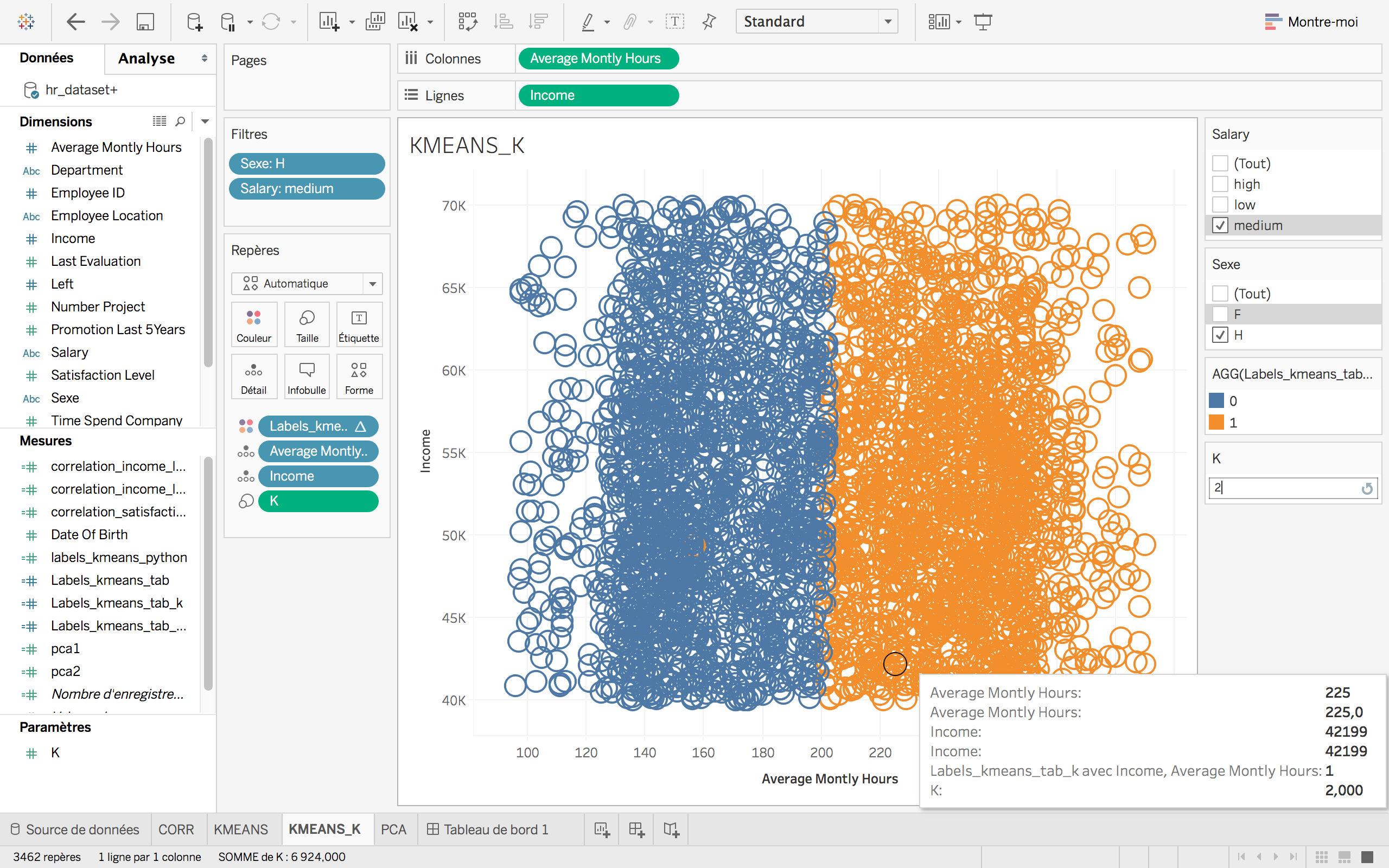January 2017
- Author: Consultant, Data scientist - Baccar Clement - clement.baccar@saegus.com
TabPy framework allow Tableau to remotely execute Python code.
It has two components:
- a server process which enables remote execution of python code.
- a client library that enables the deployments of such endpoint.
Tableau can connect to the TabPy server to execute Python code on the fly and dispay results in Tableau. Users can control data and parameters being sent to TabPy by interacting with their Tableau worksheets, dashboard or stories
-
Tableau Software 10.1 and above: download here
-
Python 2.7 and above: download here
-
Python-Tableau server package - TabPy: download here
Download the TabPy package git clone git://github.com/tableau/TabPy
or here
and launch the setup.sh or setup.bat (on Windows).
Then Tabpy is starting up and listens on port 9004
In Tableau server 10.1 a connection to TabPy can be added
Help > Settings and Performance > Manage External Service Connection
- step 1 :
- step 2:
Create a new worksheet with any data source.
This tutorial uses the hr_dataset.csv dataset available on sharepoint
To create a calculated field: analysis > create a calculated field
To compute the pearson correlation coefficient between two variables use the following calculated field.
SCRIPT_REAL('
import numpy as np
return np.corrcoef(_arg1,_arg2)[0,1]
',
AVG([Income]),AVG([Left])
)
_arg1 and _arg2 are the parameters passed to the SCRIPT_REAL function.
SCRIPT_REAL,SCRIPT_BOOL, SCRIPT_INT,SCRIPT_STR define the value type that will be return by the script function.
It can be used for R or Python script
Then display the correlation coefficient on the details windows.
Notice that the correlation coefficient is compute with the displayed data on the worksheet.
This part describes how to execute a very simple clustering algorithm: Kmeans, in a python script and then displayed in Tableau.
Create a new python script, let's called it : kmeans.py
import tabpy_client
import numpy as np
from sklearn.cluster import KMeans
from sklearn.preprocessing import StandardScaler
connection = tabpy_client.Client('http://localhost:9004/')
def kmeans(var1,var2,kcluster):
X = np.column_stack([var1,var2])
X = StandardScaler().fit_transform(X)
kmeans = KMeans(n_clusters=int(kcluster[0]), random_state=0).fit(X)
return kmeans.labels_.tolist()
connection.deploy('Kmeans-clust',kmeans,'Returns the clustering label for each individual',override=True)
Then execute the python script by : python kmeans.py to deploy the kmeans function.
-
tabpy_client.Client('http://localhost:9004/')create a connection between our python script and TabPy (listens by Tableau Software). -
connection.deploy()deploy our python function calledkmeansto TabPy server. -
override=Trueenable to re-write and modify thekmeansfunction. -
kmeans()define our clustering function and return the output labels.
The Kmeans algorithm requires to choose ,a priori, the K - number of cluster.
Create a new parameter called K that could be modified and change the given number of cluster.
Create a new calculated field with the following structure:
SCRIPT_REAL('
return tabpy.query("Kmeans-clust",_arg1,_arg2,_arg3)["response"]',
ATTR([Income]),ATTR([Average Montly Hours]),
[K]
)
The labels might be display on a two-dimensional mapping. Display the K parameter and change the actual value of K cluster.
- for K=2
- for K=3
Notice that the K-Means algorithm is compute with the actual dataset displayed on the worksheet.
The main linear technique for dimensionality reduction, principal component analysis, performs a linear mapping of the data to a lower dimensional space in such a way that the variance of the data in the low-dimensional space representation is maximized (wikipedia)
In this example, we choose three variables: Income, Average Monthly Hours, Time Spend Company that we would like to display on a two-dimensional space.
So we created two python script returning the components coordinates: pca1.py and pca2.py.
import tabpy_client
import numpy as np
from sklearn.decomposition import PCA
from sklearn.preprocessing import StandardScaler
connection = tabpy_client.Client('http://localhost:9004/')
def pca1(_arg1,_arg2,_arg3):
X = np.column_stack([_arg1,_arg2,_arg3])
X = StandardScaler().fit_transform(X)
pca = PCA(n_components=2)
pca.fit(X)
X = pca.transform(X)
return X[:,0].tolist()
connection.deploy('pca1',pca1,'Returns PCA coordinate 1',override=True)
pca2.py returns X[:,1]
Called the pca functions with the following calculated field:
SCRIPT_REAL('
return tabpy.query("pca1",_arg1,_arg2,_arg3)["response"]',
ATTR([Income]),ATTR([Average Montly Hours]),ATTR([Time Spend Company])
)
Notice:
-
the PCA is compute with the actual dataset displayed on the worksheet.
-
to properly interpret data, PCA requires a deeper statistical analysis (correlation circle, eigenvalues and eigenvector analysis)
Example of new tools that could be implemented in Tableau Software:
- Provided more insight to select the right number of k in Kmeans (inertia analysis for k going from 1 to 10)
- Provided more statistics insight to perform a proper PCA analysis (correlation circle, eigenvalues analysis)
- Provided other algorithm to dimension reduction (non linear)
- Performed predictive analysis on the
leftvariable. (cf. Kaggle python script) - similar tools could be implemented in
Ron Tableau and onDigdash






